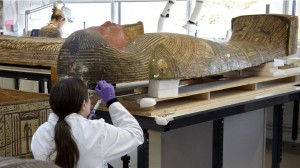 Oxford University’s Ashmolean Museum will put its collection of 40,000 ancient Egyptian and Nubian artifacts back on display in six refurbished galleries starting this Saturday, November 26. The collection includes a large number of human mummies and objects that have been part of the museum’s collection since the 17th century. Over half of the mummies and coffins have been in storage for decades and will go on display for the first time in the new galleries.
Oxford University’s Ashmolean Museum will put its collection of 40,000 ancient Egyptian and Nubian artifacts back on display in six refurbished galleries starting this Saturday, November 26. The collection includes a large number of human mummies and objects that have been part of the museum’s collection since the 17th century. Over half of the mummies and coffins have been in storage for decades and will go on display for the first time in the new galleries.
The Ashmolean is home to some of the finest Egyptian and Nubian collections in the country, with Predynastic and Protodynastic material which ranks amongst the most significant in the world. With new lighting, display cases and interpretation, the project completes the Ashmolean’s Ancient World Floor, comprising galleries that span the world’s great ancient civilisations – from Egypt and Nubia, Prehistoric Europe, the Ancient Near East, Classical Greece and Rome, to India, China and Japan. […]
Professor Andrew Hamilton, Vice-Chancellor of the University of Oxford, said, “These remarkable collections are among the most important outside Egypt and one of the Ashmolean’s most popular attractions. With an exciting series of new galleries, the redevelopment transforms opportunities for using the collections for teaching and research at all levels, and the way they are enjoyed, cared for and integrated within the wider Museum.”
 Each gallery is dedicated to a chronological period of ancient Egyptian and Nubian history. The first one is Egypt at its Origins, covering Egypt’s history from the Paleolithic era to the Early Dynastic period (ca. 3000 B.C.), includes some of the oldest stone sculptures in the world and the colossal limestone statues of the fertility god Min. Next is Dynastic Egypt and Nubia (2686 B.C. to 1540 B.C.) whose centerpiece is the Shrine of Taharqa, part of the temple of Amun at Kawa, in what is now Sudan, and the only complete free-standing pharaonic building in Britain. Life after Death in Ancient Egypt focuses on the tools and methods the Egyptians used to mummify and secure eternal life.
Each gallery is dedicated to a chronological period of ancient Egyptian and Nubian history. The first one is Egypt at its Origins, covering Egypt’s history from the Paleolithic era to the Early Dynastic period (ca. 3000 B.C.), includes some of the oldest stone sculptures in the world and the colossal limestone statues of the fertility god Min. Next is Dynastic Egypt and Nubia (2686 B.C. to 1540 B.C.) whose centerpiece is the Shrine of Taharqa, part of the temple of Amun at Kawa, in what is now Sudan, and the only complete free-standing pharaonic building in Britain. Life after Death in Ancient Egypt focuses on the tools and methods the Egyptians used to mummify and secure eternal life.  The Amarna Revolution singles out the reign of King Amenhotep IV and the unique religion and art produced under him. Egypt in the Age of Empires depicts daily life in ancient Egypt using the documents found engraved on limestone chips at Deir-el-Medina, the village where construction workers building royal tombs lived during the New Kingdom (ca. 1000 B.C.). The last gallery is Egypt meets Greece and Rome which displays artifacts from Ptolemy’s accession to the throne of Egypt after the death of Alexander.
The Amarna Revolution singles out the reign of King Amenhotep IV and the unique religion and art produced under him. Egypt in the Age of Empires depicts daily life in ancient Egypt using the documents found engraved on limestone chips at Deir-el-Medina, the village where construction workers building royal tombs lived during the New Kingdom (ca. 1000 B.C.). The last gallery is Egypt meets Greece and Rome which displays artifacts from Ptolemy’s accession to the throne of Egypt after the death of Alexander.
The original Egyptian rooms were apparently dark and pokey. The new galleries are bright, open and airy to facilitate visitor traffic flow and show off this extraordinary collection to its best advantage. That they’ve successfully built new interior spaces, moved 40,000 objects to and fro, including colossal statues and huge display cases in only 12 months while the rest of the museum was open is astonishing. It took them two months just to move artifacts into the new rooms.
That would be cool to see.
But! I’ve had a great idea. Imagine this, Viking Week. Evey day a new viking story. Then everyone who orders a copy of the transcript gets a free viking nose! It will be a great promotion!
You’re a born history programming executive. Although it could use more aliens.
So, the Vikings originally came from Egypt before they landed in Oxford and founded the Ashomolean Museum? And it is all revealed by close study of the unnoticed detail in Leonardo’s Sistine Chapel Ceiling… Who knew?!
I do appreciate a solid Grand Unified theory.
And it also reveals that “Ashomolean” is the correct spelling of “Ashmolean” (with profound numerological implications).
Hey, who you calling an Ashomolean? Sheesh. Type emails to your mother with that hand?